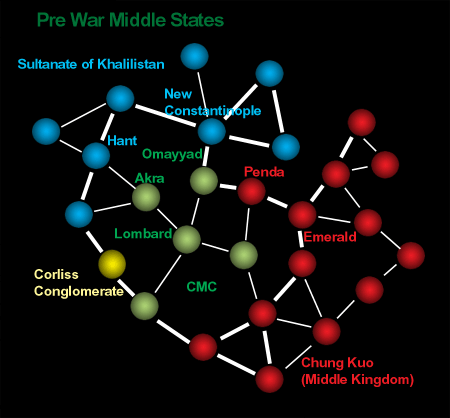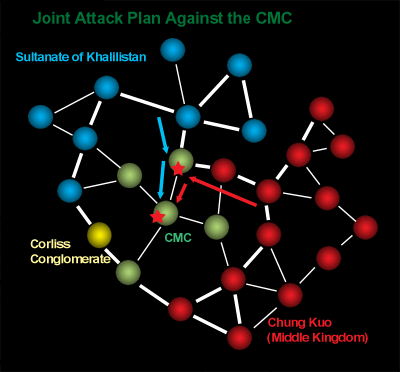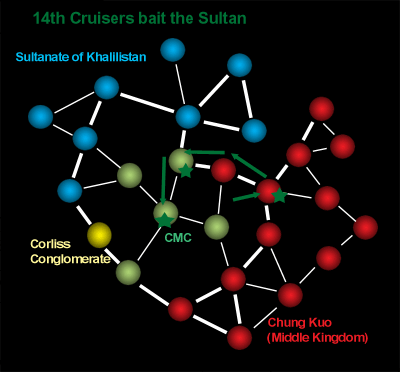|
|
The Founding of the Middle States
As with all historical periods of exploration, exploitation, and colonization, the development of the Middle States was a function of the demand (the pressure driving/reward associated with outward expansion), the technology (the ability to go further and exploit without undue risk), the stellar geography, and the political will (the resources, the vision, the economics, the popular support [if applicable]).
At the time that this region was opening up, the cost of exploration and colonization was still exorbitant. Only larger economic powers could afford to develop new star systems, and set up the infrastructure for more permanent presence. This meant that only governments, a few mega corporations, and often collaborations of both pushed the frontiers of Human expansion back.
The Middle States was settled by three large powers. The Chinese government formed the Middle Kingdom. The Consortium of Arabic Nations formed the Sultanate of Khalilistan. And the massive Consolidated Mining Corporation (CMC) wedged between the two.
The Sultanate controlled large neutronium and water reserves. The Middle Kingdom developed a solid industrial base and vast agricultural developments on the terrestrial planet Emerald. The CMC controlled the trade routes and asteroid belts between the two empires. Its survey teams explored and prospected every system and jump route. Its skilled mining crews work for all.
For years the CMC managed to keep its systems independent by playing the two larger powers against one another. This policy failed when the Middle Kingdom and Sultanate reached an agreement to capture the CMC systems and partition them, thus eliminating an expensive and annoying middleman.

The War of Dissolution
What was referred to as the War of Blunders in New Constantinople, the War of Treachery in Tau Tsun, and dubbed the War of Tears by those on Emerald is now generally called the War of Dissolution. While the Independence War in the Commonwealth took several years to build and flare to its peak, the War of Dissolution was remarkably short-lived. However, it was as intensely destructive as any war. The two wars were clearly related, in that the one spilled over into and sparked the other. However, to say that the Commonwealthís civil war (The Independence War) was fought in the Middle States is misleading. The War of Dissolution was waiting to happen, and needed only the impetus provided by the Independence War. Nevertheless, it was a conflict that devastated the entire Middle States cluster.
Just before hostilities erupted in the Middle States, the CMC was undergoing a kind of internal schism. Those most loyal to the CMCs original mission felt that trying to govern several star systems interfered with mining, refining, and the power that comes from profit. Those charged with policing and settling disputes in the system (mostly its naval forces) felt that the CMC was woefully inadequate at governing, and should work more for the interests of the people inhabiting its systems than for its shareholders. This latter group, supported largely by the bulk of Naval forces established a charter as a political administration, and set up a government to run the five systems it controlled. They called themselves The League of Independent Stars (LIS), and they made it clear that they were going to pursue a number of aggressive trade and militarization policies. The CMC had always been caught between two stronger powers, and felt that it had been intentionally weakened by them. The League, controlling the main shipyards, the fleet, and other key trade interests within CMC space decided that it was time to strengthen their position in the cluster. The choice of names was intended to win the favor of the fiercely independent Corliss Conglomerate, but it also served as insult and taunt to the two powers straddling them. Unfortunately, the choice of name was also stupendously bad timing, given what was stirring in the Commonwealth systems at the same time.
The LIS was overly confident that their respective neighbors would continue to despise each other more than they would the new LIS. It had always been a continual struggle for the CMC to maintain its independence and neutrality between the Sultanate and the Empire, but it had always profited as the trade intermediary between the two. Efforts to placate the Sultan and ease his crippling trade practices had always failed. The Sultan had never forgotten CMCs affiliation with Emperor Leung during the debacle at Emerald. CMC had also been trying to weaken the Emperorís grip on some of the systems they wished to exploit, and were almost caught outright supporting a botched rebellion at Emerald. This was seen for what it was by Emperor Leung: an effort to destabilize his power in that critical and already disgruntled system. The CMC enjoyed only two advantages in this region: control of the systems on the trade routes joining the two larger powers, and a relatively powerful fleet of starships. By putting a new political face (the LIS) on the CMC, the five systems hoped to strengthen their position with their powerful neighbors, to win better trade concessions from the Sultan, and to finally include the independent stronghold system of Corliss in their fold. The CMC barely approved the new League by a council vote of 6 to 5. And so the LIS was born, dragging much of its economic elite along grudgingly, into an new phase of tough trade and tough politics with its neighbors.

Unfortunately, Emperor Leung had other plans. He directed his new Imperial Governor to meet secretly with the Sultan at Emerald. Within a matter of days, the two powers reached a secret agreement to partition the Middle States between them, eliminating the expensive and annoying middleman of CMC (now called the LIS) altogether. Emeraldís own rebellious freedom fighters learned of this plan and immediately sold the information to the LIS Navy in exchange for arms and ships. Once they learned of these plans, the leaders of the LIS decided to act pre-emptively. Admiral Takana of the LIS Navy was given the task of strengthening the LIS fleet, and readying it for war. The old guard of the CMC used this news to claim that the LIS was the cause of this pending war, and began to withdraw support from the League.
The LIS Navy was large and well equipped, but not large enough to take on the combined forces of the Sultan and the Emperor. The Navy knew they must not let their enemiesí combined forces mass at one location. If the LIS forces were to have any chance of surviving, they would have to strike the enemiesí forces separately. The LIS Navyís strategy was simple: They would do their utmost to discover the planned location and routes of the combined forces, and then strike each fleet separately with the entire LIS Navy before the Sultanís forces and the Emperorís could assemble. It became a war of intelligence gathering and spying. Unbeknownst to everyone, the Sultan had been using espionage and subterfuge to keep his Caliphs in line for some time. He was better at the spy game than anyone else in the cluster. It was the counter-intelligence maneuvers by Sultan Shahís Naval Intelligence spies that triggered the most destructive sequence of space battles the cluster had ever seen.
Emperor Leungís admirals worked out a plan to send their navy and the Sultanís fleet into Lombard in a coordinated two-pronged strike into the Heart of CMC space to wipe out the LIS fleet in one blow. They suggested attacks into Akra and Ripon respectively to better catch the enemy between them at Lombard. The Sultan favored another plan, based on information his spies had gathered about the LIS defenses and fleet movements. His strategists recommended gathering the two attacking fleets together first, then striking the LIS forces with the advantage of surprise in a single great battle that would end the influence of the LIS in the cluster forever (and incidentally, help him gain control of CMC entirely). The Sultanís strategists indicated that Omayyad was the only system from which this could be accomplished, adding their promise to arrive there first and secure it. The Emperorís admirals agreed to this plan and prepared the fleet for the joint strike. The Sultanís spies already knew about the deadly LIS defenses in Omayyad, as well as other LIS secrets they werenít about to reveal to the Emperorís forces.
The Sultanís spies then managed to slip information undetected to the LIS Naval Intelligence branch indicating that the rally point for the Sultanate and Imperial forces would be at Omayyad. They also inserted the additional fact that the Emperor was gathering his navy at Penda first. However, the Sultan had no intention of sending his ships to Omayyad. He did, however, intend on sending a drone into Omayyad at the appointed time, in order to send the all-clear signal to the Emperorís forces. He neglected to inform the Emperor of his actual plans, leading the Emperor of Chung Kuo into a trap of treachery and betrayal. The Imperial forces continued to prepare for a jump to Omayyad where they believed they would join forces with the Sultanís fleet.

Based on this mis-information, the LIS Navy planned its strategy based on the assumption that the two forces would link up in Omayyad before striking Lombard. The LIS forces sent a vast arsenal of automated and passive defenses into that system to strengthen the many minefields and booby traps already being put in place in that asteroid-cluttered system. They then assembled their own recently built-up fleet, and chose to intercept the Emperorís vessels as they moved from Penda to Omayyad. The LIS Navy, with its CMC background in exploration, prospecting and surveying star systems, was noted for their navigational skills. CMC surveys had predicted the existence of a usable L-point in Ripon, and an LIS advance recon team found it. They used this otherwise unknown jump point to get into the Penda system from Ripon to arrive behind the Emperorís immense attack fleet. The commander of the LIS Navy, Admiral Takana, waited for the Emperorís attack vanguard to jump out toward Omayyad. Then the LIS Navy struck the rear guard of the Emperorís fleet. Within minutes, most of the Imperial fleetís support vessels and missile cruisers were destroyed. The Emperorís greatest Admirals and ship captains were killed. The vanguard of the Emperorís forces, after having been decimated by the LISís automated defenses in Omayyad, were desperate for support. They were surprised only hours later when the late-arriving support vessels turned out to be the entire LIS Navy. The already fractured Imperial Navy panicked and fled. As they raced through Omayyad, the remains of the Imperial fleet encountered more traps and defenses set up by the LIS Navy. The majority of the Emperorís fleet died there.

The LIS Navy had suffered only a few losses at the hands of the Emperorís Navy, so they waited for the Sultanís fleet and their mercenary reinforcements to arrive from New Constantinople. They never came. While Admiral Takana was watching the last of the Emperorís ships flee, Sultan Malik Shah of Khalilistan was pulling a monumental double-cross of his own. The Sultan assembled his flotilla, made up of the personal fleets of most of the Caliphs, at the Hant system, and struck out on one of the most daring, long-reaching campaigns in space combat history. Leaving a mercenary force to defend New Constantinople, the Sultan and most of his Caliphs struck out with a fleet of their newest and fastest ships.
The Sultanís Navy had never intended on arriving at Omayyad, they struck Akra first, then Lombard and followed the most direct route to An-Chi to their ultimate goal: Emerald. After vaporizing the small defenses at Akra, they struck the populated system of Lombard, destroying everything in their path. The Sultanís fleet then jumped to Ripon, and destroyed the LIS rear guard and the main stations there in a single sweep. The Sultanís spies, scientists and navigators had already surmised what the LIS Navy had discovered, and took very little time to uncover the route to Penda. Taking a large risk, the Sultan ordered his entire fleet to jump through an untested jump point into hostile territory with uncertain defenses in order to save the time and cost it would take for him to reach his prize. His gamble paid off. Admiral Takana and his commanders were still reeling from the news of the destruction of Lombard, and the realization that they had been duped. The Sultanís quick assault drew the LIS fleet homeward to Lombard to render whatever assistance they could, and to regroup. In the meantime, the Sultanís forces arrived in Emerald and quickly overwhelmed its defense garrison. The planet was subjected to a merciless bombardment for 24 hours, completely destroying the capital city of Chíang-An, all the spaceports, and most of the planetís transportation and communications infrastructure. What Sultan Malik Shah accomplished on that single day, the 14th day of sixth month on the Emerald calendar, took the survivors of Emerald five decades to rebuild.

The LIS Navy nearly foundered at the news of this brutal treachery. Admiral Takana rallied his forces with a daring plan for vengeance. He assembled his fastest cruisers into a single strike squadron called the 14th Cruisers, and set out to strike directly at the Sultan and his Caliphs at Emerald while they waited for their ground invasion forces to arrive. The 14th Cruisers engaged in a daring frontal attack on the Sultanís Navy in orbit above Emerald, then fled back toward Omayyad. This assault, though somewhat damaging to the Sultan, was a carefully orchestrated feint. Their goal was to draw the Sultanís forces back into the traps and minefields of Omayyad and the reinforcements gathered at Lombard. The Sultan realized he could never hold Emerald without destroying the LIS navy. Despite being cautioned against pursuit by his admirals and his Caliphs, the Sultan took the bait and pursued the 14th Cruiser squadron on a blazing chase across three star systems. The 14th Cruisers suffered heavy losses on their retreat, but so did the Sultanís forces. The 14th Cruisers continued to give chase right into Lombard before the Sultanís Navy gave up. But by then the damage was done to both fleets. Caliph Al-Farabi, Caliph Mamun, and Caliph Abd-Al-Rahman had already abandoned the pursuit as madness. Others fell to the minefields, the automated weapons, and other lethal traps in Omayyad. Caliph Al-Mansur and his personal fleet followed the Sultanís orders to pursue the Cruisers directly into Lombard, but they were all destroyed almost immediately after exiting capsule space at the Lombard subsidiary L-4. The Sultan turned homeward in his severely crippled cruiser with the remnants of his fleet behind him.
The Sultan was faced with a significant problem upon his return: the mercenary forces in his employ revolted. With no plunder or new systems to offer in payment, the well armed mercenaries suddenly became a liability. A number of mercenary squadrons simply left. Others tried their hand at looting. A few mercenary ships, originating from bases in the Akra or Penda systems even turned on their employer and attacked. The result was a greatly weakened defense of the New Constantinople system. The Sultan further weakened it by sending Caliph Al-Rashid-Al-Kasim and Caliph Yezhid with their personal fleets out to search for the last of the LIS Navy. Caliph Yezhid chose to ďsearchĒ for the LIS forces in his home system of Nureddin, where he resumed his rule and reinforced his defenses.

Admiral Takana managed a fast re-supply of his operating cruisers, and assembled the remainder of the LIS Navy at the ruined shipyard at Akra. He then drove a punitive attack into Hant. They destroyed everything in the system within 12 hours. The LIS fleet then pushed into the Saladdin Caliphate and annihilated the remnants of the Sultanís navy, and the mercenary ground invasion fleet destined for Emerald that was still waiting there. The LIS Navy burned that system to ash, and jumped for New Constantinople taking the remaining defenders by surprise. Once in orbit over the Sultanís ornate domed palace and capitol city, the League Navy threatened bombardment to avenge Lombard.
Aftermath
The Sultan dispatched the Grand Wazier from his palace, to negotiate with Takana aboard his flagship. The Wazier signed a treaty to avoid the destruction of New Constantinople, guaranteeing the disbanding of the Sultanís fleet, and a promise of no further aggression. The remaining Caliphs, who had already been humiliated in the Sultanís defeat, were utterly defiant when asked to surrender their ships. They retreated to their respective Caliphates to rebuild and lick their wounds. Sultan Malik Shah was taken into custody, tried and executed for his crimes. Though his son was established nominally as his successor, the Sultanate never returned to the strength or glory of Malik Shahís rule. The last ships of the Sultanís fleet were captured, decommissioned or reassigned. The remaining Caliphs fought among themselves for the remains of the Sultanate, with Sultanís son, Omar Abu Tammam, struggling to retain control of Al Wadiís rich resources. The Saladdin Caliphate was slowly rebuilt, but was continually in contention between the Sultan Abu Tammam, and Caliph Yezhid, who became a powerful and ambitious political figure in the decades to follow.
Leungís Empire, without its fleet to enforce unity, deteriorated rapidly in a series of bloody rebellions and fragmenting political separations. It took several years to happen, but the Empire died in a series of violent spasms. The star systems that had been spared the devastation of the war, suffered equally in its aftermath. Those systems that had once been on lucrative trade routes to Sirius were now cut off. They suffered the prolonged death of starvation and abandonment. The Leungís Empire shrank to four star systems, but he managed to retained his seat of power in the Emperorís palace at Tau Tsun for an unnaturally long time.
|